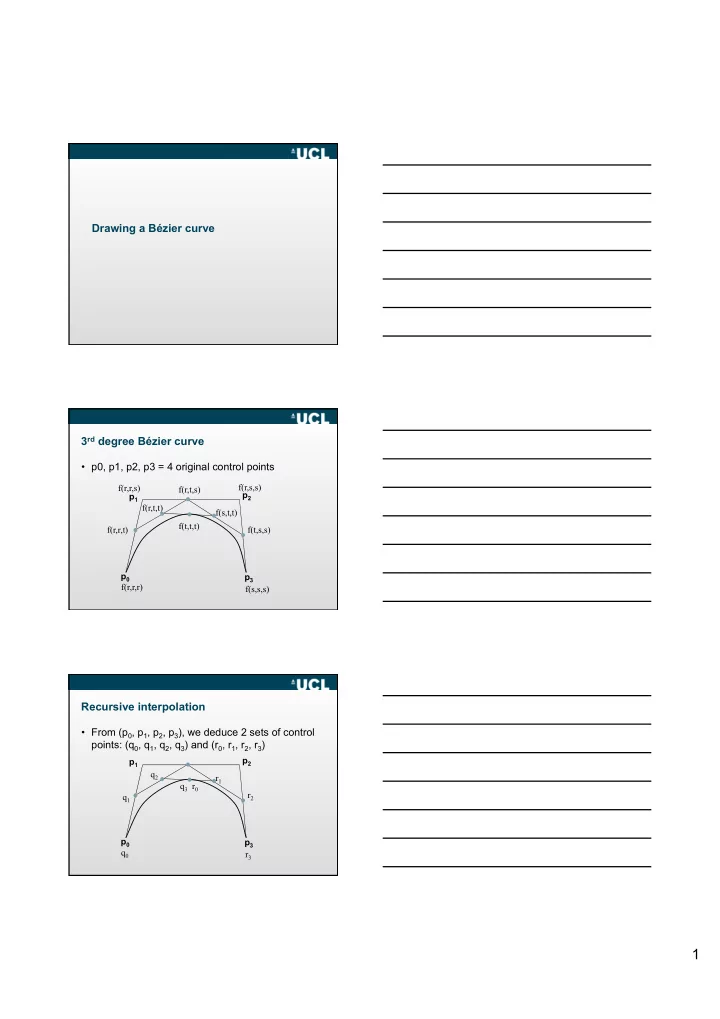

Drawing a Bézier curve 3 rd degree Bézier curve • p0, p1, p2, p3 = 4 original control points f(r,s,s) f(r,r,s) f(r,t,s) p 2 p 1 f(r,t,t) f(s,t,t) f(t,t,t) f(r,r,t) f(t,s,s) p 0 p 3 f(r,r,r) f(s,s,s) Recursive interpolation • From (p 0 , p 1 , p 2 , p 3 ), we deduce 2 sets of control points: (q 0 , q 1 , q 2 , q 3 ) and (r 0 , r 1 , r 2 , r 3 ) p 2 p 1 q 2 r 1 q 3 r 0 r 2 q 1 p 0 p 3 q 0 r 3 1
Algorithm for 3 rd degree void bezier(Point p[]) { Point q[ ], r[ ]; if(colinear(p)) { This is called draw_line(p[0],p[3]) DeCasteljau’s Algorithm } else { /* split p into q and r */ split(p,q,r); bezier(q); bezier(r); } } Colinear • Colinear checks if the 4 points p 0 , p 1 , p 2 , p 3 are aligned • Of course, you don’t get the alignment exactly (numerical problems, degree of accuracy, etc…) • We need to have an approximation • Return true if the 4 points are approximately on a straight line Colinear • If (p 0 ,p 3 ) is given by ax+by+c = 0, • Then compute the distance of p 1 and p 2 from this line • The distance should be within a certain threshold • If D 2 (x,y) = (ax+by+c) 2 /(a 2 +b 2 ), and D 2 (P 1 )< ε and D 2 (p 2 ) )< ε then the points are approximately colinear. 2
Alternative • Check if – p[0], p[1], p[2], p[3] are very close together (2 pixels) – If yes, then draw line between points p[0] - p[3] • Disadvantage – Need to apply recursion more often • In any case colinear() needs to do this check as well Split • We need to compute R and Q from P, where • q 0 = f(r,r,r), q 1 =f(r,r,t), q 2 =f(r,t,t), q 3 =f(t,t,t) • r 0 = f(t,t,t), r 1 =f(t,t,s), r 2 =f(t,s,s), r 3 =f(s,s,s) • You can split however you like, but it’s convenient to split in 2 … using t=1/2 Drawing using Explicit Equation • Remember explicit polynomial equation: – f(t,t,t) = (1-t) 3 f(0,0,0) + 3t(1-t) 2 f(0,0,1) + 3(1-t)t 2 f(0,1,1) + t 3 f(1,1,1) = (1-t) 3 P 0 + 3t(1-t) 2 P 1 + 3(1-t)t 2 P 2 + t 3 P 3 • Why not just iterate over ‘t’ and draw curve? – Increasing by t by Δ t does not correspond to equidistant spacing of f(t) f(t+ Δ t) – Unclear how to adjust step-size Δ t appropriatelty 3
Conclusions • Drawing is rather simple and efficient • Boils down to splitting curve 4
Recommend
More recommend